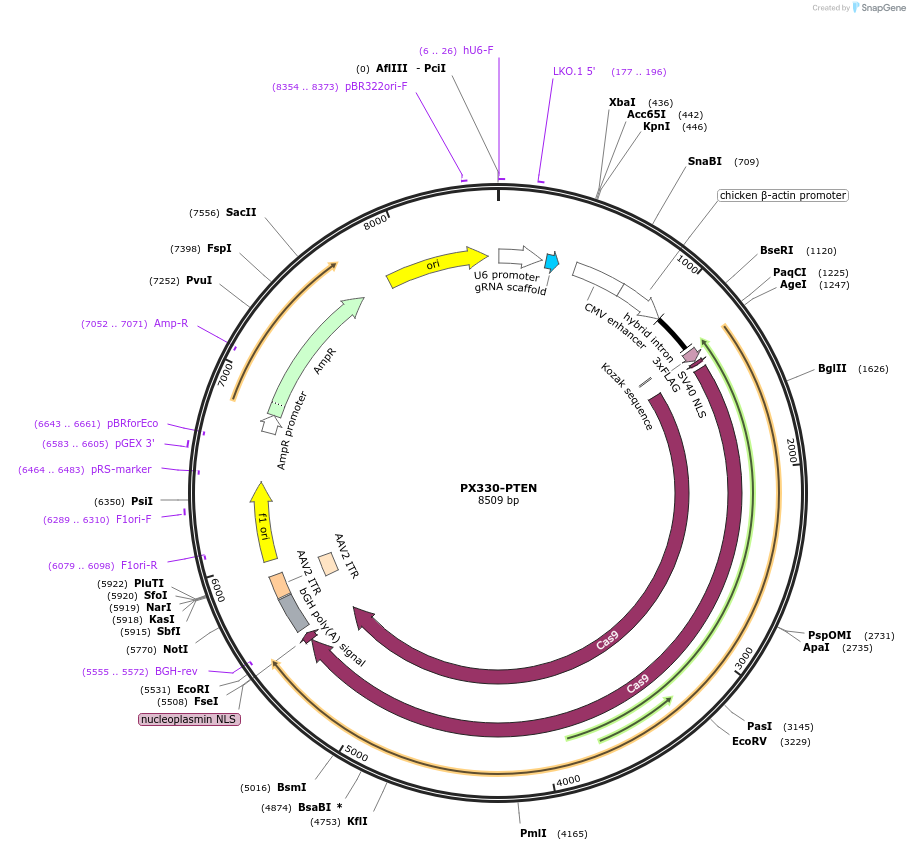PX330-PTEN
(Plasmid
#227440)
-
PurposeCas9 expression and a gRNA targeting Exon 6 of mouse PTEN
-
Depositing Lab
-
Sequence Information
Ordering
| Item | Catalog # | Description | Quantity | Price (USD) | |
|---|---|---|---|---|---|
| Plasmid | 227440 | Standard format: Plasmid sent in bacteria as agar stab | 1 | $85 | |
Backbone
-
Vector backbonePX330
-
Vector typeMammalian Expression
Growth in Bacteria
-
Bacterial Resistance(s)Ampicillin, 100 μg/mL
-
Growth Temperature37°C
-
Growth Strain(s)DH5alpha
-
Copy numberHigh Copy
Gene/Insert
-
Gene/Insert namespCas9 and gRNA for mouse PTEN
-
Entrez GenePten (a.k.a. 2310035O07Rik, A130070J02Rik, B430203M17Rik, MMAC1, PTENbeta, TEP1)
Cloning Information
- Cloning method Restriction Enzyme
- 5′ cloning site BbsI (destroyed during cloning)
- 3′ cloning site BbsI (destroyed during cloning)
- 5′ sequencing primer hU6 (Common Sequencing Primers)
Resource Information
-
Supplemental Documents
-
A portion of this plasmid was derived from a plasmid made byOriginal PX330 is from Addgene 42230
Terms and Licenses
-
Academic/Nonprofit Terms
-
Industry Terms
- Not Available to Industry
Trademarks:
- Zeocin® is an InvivoGen trademark.
Depositor Comments
Please visit https://doi.org/10.1101/2024.10.04.616644 for bioRxiv preprint.
These plasmids were created by your colleagues. Please acknowledge the Principal Investigator, cite the article in which the plasmids were described, and include Addgene in the Materials and Methods of your future publications.
-
For your Materials & Methods section:
PX330-PTEN was a gift from Tal Laviv (Addgene plasmid # 227440 ; http://n2t.net/addgene:227440 ; RRID:Addgene_227440) -
For your References section:
Genetically encoded biosensor for fluorescence lifetime imaging of PTEN dynamics in the intact brain. Kagan T, Gabay M, Meenakshisundaram A, Levi Y, Eid S, Malchenko N, Maman M, Nitzan A, Ravotto L, Zaidel-Bar R, Eickholt BJ, Gal M, Laviv T. Nat Methods. 2025 Apr;22(4):764-777. doi: 10.1038/s41592-025-02610-9. Epub 2025 Feb 20. 10.1038/s41592-025-02610-9 PubMed 39979596

